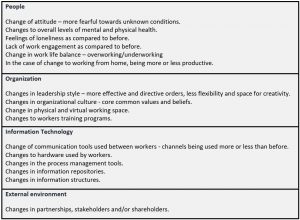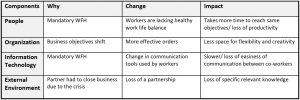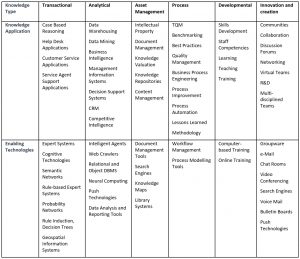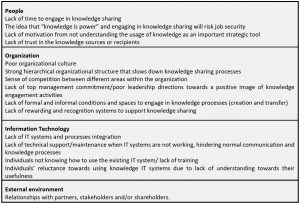
A model for enterprise knowledge management after the COVID-19 crisis
The ongoing COVID-19 pandemic has impacted significantly on enterprises. Many have been and continue to be forced to close, either temporarily due to lockdowns or staff shortages, or permanently due to negative changes that the enterprise was unable to overcome. Many other enterprises have been forced to alter organizational practices, for example, to shift to working from home (WFH).
In a recent NOVA Information Management School (IMS) Master of Information Management dissertation1, Maria Isabel Pereira Guerra Carreira reminds us that the current pandemic situation is not the first or last time that some enterprises will face crises in their lifetime. Uncertainty can come knocking at the door at any time.
Carreira advises that crisis management has arisen as a management area dedicated to considering the possibilities available in order prevent, respond, and react to such crises, with the aim of diminishing their negative impacts. However, she alerts that even though existing crisis management models and frameworks provide organizations with important tools and methods, they do not include knowledge as a key resource.
With this in mind, Carreira carries out a review and integration of research in regard to both crisis management and knowledge management (KM), to produce a practical step-by-step model of KM for post COVID-19 crisis management.
A model of KM for post COVID-19 crisis management
The objective of Carreira’s model is to provide support for efficient enterprise KM after the COVID-19 crisis, including preparation for future crises. As shown in Figure 1, there are four stages in the model, and each stage consists of specific steps.

Carreira advises that the steps should be implemented by a response team selected on the basis of expertise and availability. As KM initiatives will impact workers day-to-day activities, as well as normal knowledge processes and technology, she recommends that the assembled team consists of people management experts (i.e. human resources) in addition to KM- and IT-related experts.
Stage 1: Crisis impact assessment
In this stage, three steps can be taken to properly assess the COVID-19 (or other) crisis impact and compile the assessment results:

Identifying the changes caused by the crisis should be done through an internal assessment. An internal survey of all workers and/or individual interviews with different team leads can be used to ask targeted questions on the effects of the crisis on different knowledge components. In addition, it is also important to evaluate the impact on the environment external to the enterprise.
To assist in the selection of questions, Table 1 below lists common enterprise changes caused by the COVID-19 crisis. The table lists generic issues only. Each enterprise is unique and has its own set of changes that should be identified. In case of doubt, the response team should have open survey/interview questions where workers can express other issues they have identified. The assessment should result in information on what changes have been experienced, the root cause of these changes, and their impact.

The results of the survey/interviews are then evaluated according to the degree to which changes impacted the organization´s normal work style. As such, it is suggested that the following assessment table (Table 2) is used to compile the results. This way, the response team will be able to identify not only the negative impact caused by the crisis but also the root causes of this impact:

To prepare for the following stages, the results should be grouped according to their root cause (why). For example, based on Table 1 above, a grouping could be issues related to mandatory WFH, which affects both people and information technology.
Stage 2: Knowledge mapping
It is important to gain a good understanding of the organizations´ knowledge before deciding on which specific measures to implement. Even if a similar exercise has been carried out before the crisis, with the changes brought by the crisis, as analyzed in Stage 1 above, also comes new acquired knowledge to be taken into consideration. This stage can also be useful towards identifying the knowledge gap – the difference between what the enterprise knows and what it must know to reach its objectives. The figure below presents a macro view of the strategic knowledge gap:

The knowledge goals will be the difference between where the organization wants to go, meaning its business objectives, and what the organization knows – the identified knowledge. By acknowledging both existing knowledge and strategic goals, the organization can better grasp what it doesn’t know yet but must know to reach its objectives. This in turn will mean identifying the knowledge gap. Since knowledge identification is a complex step, knowledge mapping will be based only on relevant knowledge and strategic goals that are related with the issues identified and grouped in the first stage of the model.

The first step of knowledge mapping is identifying the relevant strategic business goals. This is an important step, as all future decisions on which KM initiatives will be based are defined by whether they are aligned with the business objectives. These objectives have usually already been decided prior to the crisis and have to do with the business/area of expertise of the organization, as well as the environment where it operates. These objectives also might have changed from pre- to post-crisis, depending on how the organization was affected.
Subsequently, and most importantly for this stage, comes knowledge identification. Knowledge identification implies identifying all knowledge domains and enablers. Knowledge domains are key knowledge holders (people), documents, or platforms with important data and explicit knowledge. Knowledge enablers are the resources that allow for the creation and transfer of knowledge – the interaction between knowledge domains.
The table below presents examples of different knowledge applications for each type of knowledge as well as their enabling technologies. The table can serve as support for the identification of knowledge enablers:

The knowledge types in the table move from most explicit to most tacit types of knowledge (left to right). As such, knowledge applications and technologies on the left-hand side of the table will allow for knowledge processes of explicit nature to occur, while knowledge applications and technologies on the right-hand side will allow for more tacit knowledge related processes to occur.
The key knowledge resources will be the sum of relevant knowledge domains, applications and/or technologies that allow for knowledge processes to take place. Key resources are mapped to the different groups of issues from step 1 of the knowledge mapping flow.
Looking again at the example of WFH from Stage 1 above, the issues gathered have implications for both people and tools. As such, knowledge domains will be key people – workers with issues and workers with expertise on such issues – as well as any documentation on topics related to these issues. Looking at Table 3, knowledge enablers will allow any combination of knowledge creation and transfer of more explicit nature, for instance the tools that bring up the issues themselves, as well as processes of tacit nature such as communities and collaboration between co-workers. Thus, the final knowledge mapping resources could be:

Stage 3: KM planning
From the results of the crisis impact assessment and the knowledge mapping process, it is possible to create a KM plan. The objective is to plan the KM actions to implement in order to combat the negative impact of the crisis and optimize knowledge resource usage.
Since KM affects different areas of expertise, this plan consists of different programs, being sets of short- to long-term multidisciplinary projects.
The figure below presents the steps to be taken in order to plan the programs:

From the different groupings of issues, the response team should be able to identify what potential knowledge strategies making use of knowledge resources the organization can apply in order to combat the negative impact caused by such issues. In this step, it is important to reflect on whether the previously identified resources are enough, or if the further outsourcing of knowledge resources is necessary. When creating these knowledge strategies, the team should also bear in mind the organization´s final strategic goals, as the knowledge strategies should support business progress towards those goals. The model suggests the creation of the table below, listing issues, potential knowledge strategies, and knowledge resources for each issue:

As can be seen in the example, knowledge strategies consist of the combination of exploration and exploitation strategies from internal and external knowledge resources. The knowledge strategies are ways of optimizing knowledge usage to mitigate the issues caused by the crisis. These knowledge strategies are ideas of ways to use not only existing knowledge resources but also potential external resources that could be useful to solve the issues. The knowledge resources compiled during knowledge mapping will serve as a baseline for creating the knowledge strategies.
The final step of this stage consists of setting-up necessary investment in specialized, feasible programs to address the negative results of the crisis. The programs are created based on the ideas for knowledge strategies. By defining specific programs to implement the strategies, the team can verify how manageable and realistic the knowledge strategies are. Taking for instance the examples in Table 5 above, the second strategy might not be realistic considering time constraints of workers. As such, the organization might decide to move forward only with specific programs to implement the first and third knowledge strategies.
Specific parameters should be defined as in any other enterprise project – including a brief description, priority status, time frame, budget and allocated resources, objectives and responsible staff:

Stage 4: Future crisis preparation
As a new crisis can strike at any minute, the final stage of this model is preparedness for future crises. The lessons learned from the COVID-19 crisis in Stages 1 to 3 above can help with this.

The first step in this stage should be to compile all KM documentation from the previous stages – from issues identified, to knowledge resources, knowledge strategies, and final KM programs. This documentation will be useful to have for future crises, as a baseline for faster KM mitigation of crisis consequences.
Secondly, it is of high relevance to obtain feedback from workers on the progress of the KM projects, evaluating if the final objectives are being reached. This should be done by presenting the KM programs to workers and providing a questionnaire to obtain such feedback.
Since KM success relies on the engagement of all workers, asking for more feedback can add to the contribution of everyone towards KM initiatives, as well as further assist the prevention of future crises. With the aim of identifying further KM barriers that go beyond the COVID-19 crisis, the team can in addition explore worker´s take on other issues they have been facing, based on generic KM barriers.
The table below comprises common challenges faced by enterprises by KM component, providing support to this further identification of issues:

Header image source: iStock.
Reference:
- Carreira, M.I.P.G. (2021). A model for enterprise knowledge management after COVID-19 crisis (Master’s dissertation, NOVA Information Management School). https://run.unl.pt/bitstream/10362/129183/1/TGI0473.pdf. ↩
Also published on Medium.






